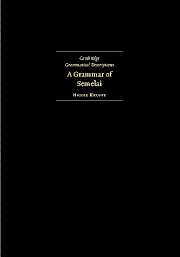Book contents
- Frontmatter
- Dedication
- Contents
- Tables and figures
- Preface
- Acknowledgements
- Abbreviations and conventions
- Maps
- 1 Semelai
- 2 Phonology and phonotactics
- 3 Morphology
- 4 Word classes
- 5 The verb
- 6 Pronouns: personal, ignorative, and demonstrative
- 7 The noun phrase
- 8 Prepositions and the prepositional phrase
- 9 Grammatical relations, constituent order and coding strategies
- 10 Basic clauses
- 11 Complex clauses
- 12 Expressives
- 13 The quotative marker, interjections and discourse clitics
- 14 Texts
- Vocabulary
- References
- Index
9 - Grammatical relations, constituent order and coding strategies
Published online by Cambridge University Press: 05 November 2014
- Frontmatter
- Dedication
- Contents
- Tables and figures
- Preface
- Acknowledgements
- Abbreviations and conventions
- Maps
- 1 Semelai
- 2 Phonology and phonotactics
- 3 Morphology
- 4 Word classes
- 5 The verb
- 6 Pronouns: personal, ignorative, and demonstrative
- 7 The noun phrase
- 8 Prepositions and the prepositional phrase
- 9 Grammatical relations, constituent order and coding strategies
- 10 Basic clauses
- 11 Complex clauses
- 12 Expressives
- 13 The quotative marker, interjections and discourse clitics
- 14 Texts
- Vocabulary
- References
- Index
Summary
In Chapter 9 the discussion centres around grammatical relations, constituent order and coding strategies. In addition to the three grammatical relations A, S, O, a fourth member, indirect object (IO), is identified. The IO exhibits dual membership – it is coded as an oblique in a prepositional phrase, but exhibits the syntactic behaviour associated with a core role (§9.1.4).
The most frequently employed constituent order is verb initial, with either A and O, or S placed after the verb. Various pragmatically determined permutations are possible, and these are outlined in §9.2.
The coding of grammatical relations is dependent on the transitivity of the clause, and it is in accordance with this distinction that they are discussed in §9.3.
The minimal clause in Semelai consists of just the predicate. The means of representation of NPs in the clause and zero anaphora are discussed in §9.4.
9.1 Grammatical relations
Grammatical relations can be divided into core and oblique (Andrews 1985). In Semelai, the distinction is validated by their differing morphological and syntactic behaviour. Core grammatical relations are central to syntactic processes such as causativisation and relativisation, and have distinctive patterns of NP-marking and verbal cross-referencing. A clear distinction between the core and non-core constituents can be established by examining relativisation, interrogative formation, fronting and the distribution of possessor =hn ‘3poss’ (§9.1.3).
- Type
- Chapter
- Information
- A Grammar of Semelai , pp. 247 - 268Publisher: Cambridge University PressPrint publication year: 2004



